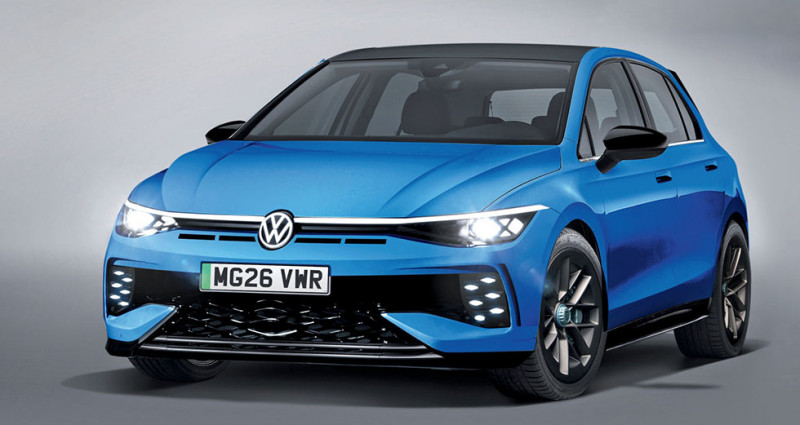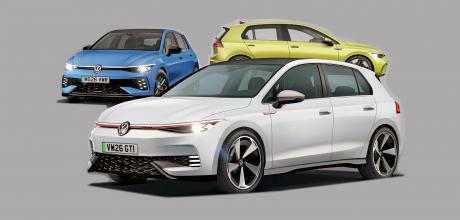2027 Volkswagen Golf Mk9 - all-electric reinvention on the way
Affordability to be key for all-electric ninth-gen Golf Segment-defining hatchback set for radical reinvention as family-friendly EV.
THE NEXT ROUND WILL BE VERY DIFFERENT
The most radical Golf ever – but GTI and R survive -You didn’t really think they’d ditch it, did you?
The ninth-generation Volkswagen Golf is shaping up to be the most radically reinvented iteration of the ever-popular family hatchback yet, ushering in all-electric power and a raft of technology as part of an allen-compassing transformation plan for the VW brand. Despite the ID 3 being commonly regarded as an electric alternative to the Golf, Volkswagen boss Thomas Schäfer sees the former as “more a Golf Plus”. The two cars share a very similar footprint, but the EV’s lack of an engine and transmission tunnel make it tangibly more spacious inside, and even in its base form it’s much quicker than the standard Golf.

For these reasons the two models can “co-exist” in future, according to Schäfer, meaning the ID 3 wouldn’t necessarily be retired after the arrival of a new, all-electric Golf. The two cars would be obviously differentiated by bespoke styling and capabilities in a bid to carve out a distinct positioning for each, and Schäfer’s commitment to preserving Volkswagen’s bestknown models names means the Golf badge can live on. “The Golf name specifically has huge value,” he told Autocar. “But at the same time, the ID brand has gained huge momentum. The recognition it receives at [customer] clinics: people absolutely understand what we’re talking about. So to change the name to something completely different doesn’t make sense.”

The ID Golf, as Schäfer has suggested it could be called, would sit between the upcoming ID 2, which will in effect replace the Polo from 2025, and the ID 3.
It isn’t expected to arrive before 2027, given that the current Golf is due an extensive mid-life overhaul in the coming months to sustain its popularity for another three to four years. The electric Golf is also tipped to be one of the first volume-production cars to ride on the Volkswagen Group’s long-awaited SSP platform, which will eventually be rolled out across the line-up as a replacement for the ubiquitous MEB skateboard structure.
This new platform was originally due for volume production in 2026 but has been beset by well-publicised development delays (which have forced sibling brand Audi to use a platform from SAIC for its next-generation Chinese-market EVs). Compared with MEB, the SSP architecture promises a step-change in terms of performance and utility, which means the electric Golf could be one of the most technologically advanced family hatchbacks on the market when it lands. “The SSP architecture will balance the need for scale and standardisation with differentiation and speed,” VW Group CEO Oliver Blume said recently, touting a suite of technological advances that will mark out VW’s second-wave EVs from its first.
Chief among these upgrades will be the integration of 800V electrical architecture, which will allow for charging speeds far and above the 175kW maximum rate of the VW Group’s current EVs. Cars based on SSP will be able to top up from 10-80% capacity in as little as 12 minutes, VW has said, compared with the 35 minutes of the latest MEB cars and quicker even than today’s fastest-charging road cars.
The platform and its associated ‘2.0’ software stack are also being designed to accommodate levelfour autonomous driving functionality – which means any Golf model using these systems could allow for prolonged periods of hands-off driving, where and when local laws permit.
But of perhaps most importance, considering the Golf’s long-held position as one of the world’s best-selling cars, is that Volkswagen is prioritising affordability for its next generation of EVs. As a result, the ninth Golf is expected to be more comparable in price with its predecessor than the ID 3.
The VW Group’s new ‘Unified’ battery cells will be developed and produced in-house and shared across all EVs from all brands in order to shave production costs, and a much higher degree of component sharing across the board will boost economies of scale and again cut the cost of bringing each car to market.
With these systems in place, Blume has suggested, “most” SSP-based EVs can achieve profit-margin parity with the company’s combustion-engined cars, with development costs slashed by 30% compared with MEB-based cars, all of which means these next-generation EVs can be cheaper at the dealership.
Creating the all-important ninth-generation Golf will be the top priority for recently appointed Volkswagen design boss Andreas Mindt, whose ID 2all concept, which was revealed mere weeks after he replaced Jozef Kaban in the role earlier this year, previewed a bold change in design direction for Volkswagen’s EVs.
Mindt said the approach is about “transferring the DNA of our icons into the future”. He went on to identify three key pillars of the company’s future design ethos: stability, likeability and excitement. That tallies with Schäfer’s pledge to imbue an element of recognisability in future Volkswagens but without veering too far towards the retro ethos of the ID Buzz. “The brand always has to reinvent itself and bring out new things,” he said. “When we bring a new version of something, it had better be a great interpretation with the newest features.”
As such, the ninth-generation Golf will be more of a design evolution than a revolution, in keeping with all previous generations over the past half-century (see timeline, below). It will, however, take the lead from the ID 2all concept by adding a host of new cues that nod to its radically different conception.
Crucially, Schäfer added that by 2030, all of Volkswagen’s cars “will have buttons” as their primary interior controls. The move is in line with his plan to bolster the usability of mass-market models by moving away from the often criticised touch controls of today’s ID cars.
Schäfer also confirmed plans to electrify Volkswagen’s existing performance subbrands, telling Autocar it would be “crazy” to let the GTI and R badges “die and slip away”. He described the GTX badge that adorns the brand’s most potent EVs today as an identifier that was being used “en route” to an all-electric line-up, suggesting that it could be phased out as the brand’s line-up of sporting EVs is expanded. That means the upcoming performance versions of the ID 7 and ID Buzz could be the last to use the badge.
Earlier this month, a more concrete vision of the electrification of the GTI lineage was given by a trademark filing in Germany, in which the ‘I’ (originally standing for injection) is replaced by a lightning bolt.
“GTI with [the] Golf was always legendary,” Schäfer said. “We will carry on. We need substance to it, with performance. We’re working on a performance model with EV to carry GTI forward.” His remarks suggest the electrification of the Golf GTI and Golf R is almost as important as introducing an electric version of the standard car. A hot variant of the front-driven ID 2 is expected to be the first to bear the GTI badge, while R will continue to be reserved for four-wheel-drive sporting models.
Schäfer added: “You need models that are exciting. R has always been our exciting place. We’ve spent a lot of time and money to get that brand, and we’re not going to give that up. “But we’re only going to call it R if it’s an R in terms of performance, in terms of all-wheel drive. There’s always GTI – two-wheel drive, exciting hot hatches and so on. We will keep this. This positioning works.”
Blume hinted at the scope for wildly powerful performance cars based on the SSP structure, touting a maximum power output of 1700bhp for the platform. Such figures are likely to remain the preserve of electric Porsche, Lamborghini and Audi supercars, rather than anything wearing a VW badge. Accessible performance will remain key for any hot Golf models, which will rival a raft of new electric hot hatches, from the Alpine A290 and Abarth 500e to the MG 4 X Power and Hyundai Ioniq 5 N.
The electric Golf is tipped to be one of the first cars to ride on the long-awaited SSP platform
ID 3 is currently seen as an electric alternative to the Golf, but VW says it and a Golf EV can co-exist


